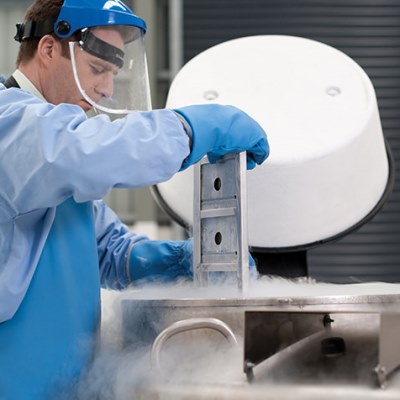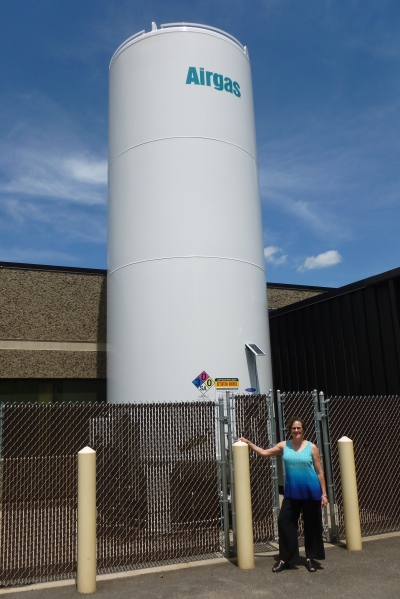You are here
How Cord Blood Banks Protect their Storage Tanks
Within the past year, there have been two big stories in the news about biobanks where the storage tanks were accidentally allowed to warm up for a prolonged period of time, leading to the destruction of the cryogenically preserved cells and tissues which they held. The first incident happened at a cord blood bank in Singapore that is owned by the company Cordlife Group Limited1. An inspection by the Ministry of Health discovered that a number of temperature excursions had gone undetected in seven of 22 storage tanks1. An in-depth investigation, which is still ongoing, found that 5,300 cord blood units in one storage tank and a few units in a dry shipper where no longer viable2. The second incident happened at the Karolinska Institutet for research in Sweden3. During the Christmas holiday of 2023, the valve which allows for automatic refilling of liquid nitrogen was turned off as part of construction work, and it was not turned back on for several days due to a lack of clarity as to who was responsible for the freezer maintenance during this time period3. This failure led to a warm up in 16 cryogenic tanks which destroyed 34,400 biobank samples, 3,800 samples from animal models, 2,600 samples from cell lines and 6,300 samples with manipulated/edited cell lines3.
Parents that hear about these incidents may understandably start to worry whether paying to store their child’s cord blood and birth tissues is a risky proposition. The purpose of this article is to explain that, under standard operating procedures, cord blood banks normally have multiple overlapping levels of safeguards in effect to protect the samples in their storage tanks.
 A cryopreservation tank is not like your kitchen freezer, where anonymous packages keep getting shoved around and stuff in the back is forgotten. Before going into storage, the cord blood stem cells are mixed with a cryoprotectant, and then cooled slowly in a controlled rate freezer. The bags containing stem cells are placed in protective metal canisters and sealed with an overwrap. Everything is labeled with a bar code. The tanks in biobanks contain racks which hold the canisters of frozen cells, and records are kept of which samples were loaded where in the racks. When cord blood units are added or removed from the tank, the top lid is opened, and a technician removes a rack to make the transfer as quickly and efficiently as possible.
A cryopreservation tank is not like your kitchen freezer, where anonymous packages keep getting shoved around and stuff in the back is forgotten. Before going into storage, the cord blood stem cells are mixed with a cryoprotectant, and then cooled slowly in a controlled rate freezer. The bags containing stem cells are placed in protective metal canisters and sealed with an overwrap. Everything is labeled with a bar code. The tanks in biobanks contain racks which hold the canisters of frozen cells, and records are kept of which samples were loaded where in the racks. When cord blood units are added or removed from the tank, the top lid is opened, and a technician removes a rack to make the transfer as quickly and efficiently as possible.
The interior of the cryogenic tank is maintained at the ultra-cold temperature of liquid nitrogen, which is -1960 C. Cells are composed mostly of water, which is why a cryoprotectant is added to prevent the cells from expanding and rupturing during freezing. Water freezes to ice below 00 C, and it undergoes a transition to glass below -1360 C4. At the cryogenic temperature of -1960 C, cellular activity has stopped, and the cells are in suspended animation5. Many biobanks have adopted the temperature -1500 C as the safety threshold at which alarms are triggered, before the tank reaches -1360 C.
 Supplies of liquid nitrogen (LN2) are essential to the operation of cryogenic biobanks. The preserved cord blood units can be immersed in the LN2, but are typically suspended in the vapor phase above a pool of LN2. The LN2 is constantly boiling and must be refilled periodically, hence a biobank must have a huge tank of reserve LN2 outside the building. Depending on the design of the cryogenic tank, so long as the lid stays sealed it can maintain a safe temperature without LN2 refills for several days to over two weeks6. Even if a severe event causes an electrical power failure at the biobank, all biobanks have back-up generators. A cryogenic tank should not have a catastrophic warming that damages the resident samples unless proper tank maintenance is neglected for a prolonged period of time.
Supplies of liquid nitrogen (LN2) are essential to the operation of cryogenic biobanks. The preserved cord blood units can be immersed in the LN2, but are typically suspended in the vapor phase above a pool of LN2. The LN2 is constantly boiling and must be refilled periodically, hence a biobank must have a huge tank of reserve LN2 outside the building. Depending on the design of the cryogenic tank, so long as the lid stays sealed it can maintain a safe temperature without LN2 refills for several days to over two weeks6. Even if a severe event causes an electrical power failure at the biobank, all biobanks have back-up generators. A cryogenic tank should not have a catastrophic warming that damages the resident samples unless proper tank maintenance is neglected for a prolonged period of time.
Many countries and even regions within countries have mandatory quality standards for the operation of cord blood biobanks, and this website has a page devoted to accreditation standards around the world7. There are also two international organizations which provide accreditation standards designed specifically for cord blood banking; they are the Association for the Advancement of Blood & Biotherapies (AABB) and the Foundation for the Accreditation of Cellular Therapy (FACT)8,9. Accredited laboratories are required to periodically undergo repeat inspections to monitor compliance.
One of the biggest components in the regulatory compliance of biobanks is to routinely check and record the temperatures in the storage tanks. The temperature sensors in the tanks may be thermocouple probes or Resistive Temperature Devices (RTDs). The RTDs are more accurate, especially at very low temperatures, but some banks use thermocouples because they are less expensive10. Either type of sensor can successfully monitor temperatures if used correctly.
Accreditation standards require biobanks to have designated personnel that are responsible for monitoring the equipment. There should be a Designated Laboratory Technician that is responsible for performing the routine maintenance and calibration of laboratory equipment. There should also be a Laboratory Supervisor that is responsible for reviewing the results of the maintenance and calibration tasks. The tables below itemize the maintenance tasks to be performed daily and annually.
Hopefully, this summary should reassure parents that biobanking is a well-established scientific field and that commercial biobanks normally have multiple overlapping safety protocols.
Daily Maintenance of Liquid Nitrogen (LN2) Tanks |
Laboratories must always observe universal safety precautions for blood and other cellular products. |
The laboratory shall provide standardized procedures for the daily maintenance of the LN2 tanks. |
The level of LN2 in the tank should be measured daily and a log of the readings must be maintained. The Designated Laboratory Technician must verify that the readings are recorded on the log sheet corresponding to the tank being monitored. |
The temperature in the LN2 tanks must be continuously monitored and recorded. Any temperature excursion beyond a set threshold (usually -1500 C) should trigger an alarm that is relayed to the Designated Laboratory Technician. |
Confirm that the saturated liquid nitrogen temperature is correctly programmed in the control panel of the liquid nitrogen tanks. |
The Designated Laboratory Technician is responsible for the periodic calibration of the thermocouple probes and/or quality control of the temperature sensors. |
The Laboratory Supervisor is responsible for reviewing the results of the maintenance and calibration. Any discrepancies will be measured again and investigated. |
If there is a noticeable increase in LN2 usage, notify the Supervisor and contact the tank vendor. This could indicate a breach in the storage tank integrity. |
All completed records will be stored in a manner that will facilitate effective retrieval and prevent damage or deterioration. |
Annual Maintenance of Liquid Nitrogen (LN2) Tanks |
The laboratory shall provide standardized procedures for the annual maintenance of the LN2 tanks and associated equipment. |
Temperature sensors and thermocouple probes are calibrated upon installation and annually thereafter, or as needed. Calibration upon installation is performed by the vendor. If the routine quality control of the probes fails, then staff are responsible for arranging calibration within 24 hrs. |
Routine equipment maintenance is performed annually. Change of solenoid valve in the LN2 tanks is performed every two years. |
Accreditation is recommended because the standards describe the minimum acceptable requirements for facilities providing these services. These standards augment, rather than replace, any federal or state requirements. These stringent standards cover all aspects of operation, including:
|
All completed records will be stored in a manner that will facilitate effective retrieval and prevent damage or deterioration. |
References
- Ministry of Health Singapore. Investigation of Cordlife Group Limited for Suboptimal Storage Temperature for Cryopreserved Cord Blood. Press Release Highlights. Published 2023-11-30
- Ministry of Health Singapore. Update On Investigation of Cordlife Group Limited. Press Release Highlights. Published 2024-04-08
- Karolinska Institutet. Several causes of the freezer failure according to internal report. News from Karolinska Institutet. Last updated 2024-04-24
- Lucas P, Pries J, Wei S, Wuttig M. The glass transition of water, insight from phase change materials. Journal of Non-Crystalline Solids. 2022; 14:100084.
- Mathew AJ. Keeping Your Baby's Precious Cells in "Suspended Animation". Parent's Guide to Cord Blood Foundation. Newsletter Published 2012-10
- Mrowiec, Z., personal communication
- Parent's Guide to Cord Blood Foundation. Accreditation Standards. Last updated 2024-05
- Association for the Advancement of Blood & Biotherapies. AABB Standards for Cellular Therapy Services. Effective date 2023-07-01
- Foundation for the Accreditation of Cellular Therapy. FACT Cord Blood Accreditation Process Requirements. Last updated 2020-07-29
- Ellab. 6 key Differences Between RTD’s and Thermocouples - that Might Change your Preferences. White Paper. Published 2019-02



 Vasiliki E. Kalodimou, PhD, CABP(H), is the director of flow cytometry and a professor of regenerative medicine at the IASO Maternity & Research Hospital in Athens, Greece. She is also Acting Chair of the European University Cyprus branch in Frankfurt, Germany, on the board of the National Hellenic Research Foundation (Ε.Ι.Ε.), and a founding member and board member of the International Regenerative Medicine Experts Society (IARMES). Dr. Kalodimou is very active within the Association for the Advancement of Blood & Biotherapies (AABB). She is an AABB Assessor, AABB Cell Therapy Mentor, on the AABB Cell Therapy Accreditation Committee, and the AABB Cellular Therapies Section Coordinating Committee.
Vasiliki E. Kalodimou, PhD, CABP(H), is the director of flow cytometry and a professor of regenerative medicine at the IASO Maternity & Research Hospital in Athens, Greece. She is also Acting Chair of the European University Cyprus branch in Frankfurt, Germany, on the board of the National Hellenic Research Foundation (Ε.Ι.Ε.), and a founding member and board member of the International Regenerative Medicine Experts Society (IARMES). Dr. Kalodimou is very active within the Association for the Advancement of Blood & Biotherapies (AABB). She is an AABB Assessor, AABB Cell Therapy Mentor, on the AABB Cell Therapy Accreditation Committee, and the AABB Cellular Therapies Section Coordinating Committee.